Extracting Rooftop Honey
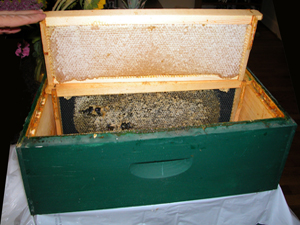 Finally,
the time had come for the first harvest of honey from Wilde and
Twain, the rooftop bee hives. Here's how it works!
Finally,
the time had come for the first harvest of honey from Wilde and
Twain, the rooftop bee hives. Here's how it works!
First, you go up to the bee hives, and you somehow get the capped frames of honeycomb away from the bees. I did this using a fume board and Fisher's Bee-Quick.
The picture at left shows the prettiest, most perfect frame of the 30 or so I pulled from the hives, as well as a more typical non-pretty frame. What makes a frame perfect? Well, you want all of the cells capped, and you want comb drawn from edge to edge. These first two considerations ensure that the honey is completely cured and that the frame holds the maximum amount.
But wait, there's more! You also want the surface of that frame to extend beyond the width of the top bar, and to be nice and even. These two characteristics make it easier to remove the wax cappings on the top, and to do so with minimum damage to the comb. The latter matters because we intend to give this comb back to the bees next year, and less damage means less repair work for them in the Spring.
There are lots of different tools for getting the cappings (which function as a moisture and contamination barrier in the wild) off of the honey. I used a "hot knife." This is a metal knife with a somewhat sharp edge that gets hot when you plug it in. By moving it carefully across the surface of the comb, you can get the honey cells open without destroying the whole business.
While extracting the honey, I also keep in mind that it is very important to limit moisture exposure: honey is dryer than the air around here, so it will suck in humidity. Over-moist honey loses its antiseptic quality, can ferment, or can become a host to bacteria. Bad bad bad. I also need to mind cleanliness: keep my hands out of my mouth, protect the honey (once it has been filtered especially) from airborne debris, and to prevent ants from getting in on the party.
The photos below show me positioning the frame above a bucket with a plastic paint filter on top that I am using as a "capping tank." This is a place to collect the premium beeswax that comes from the caps the bees place on the honey cells, and to save the honey that has been heated by the uncapping knife away from the rest of the batch. Heated honey is damaged honey, so you would use it for some less important purpose, or to give back to the bees (my plan).
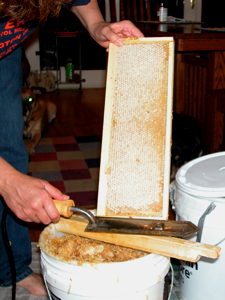
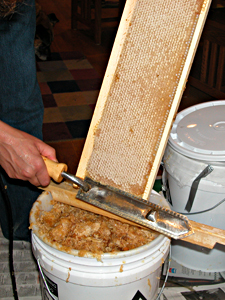
My goal here is to work carefully and slowly, creating as few gashes and dents as possible. Some beekeepers work up, some work down: I'm an "up." The close-ups below show me doing a decent job. You can see a thin layer of wax being parted from the comb, without too much honey dripping off. I do this, little by little, the whole way up the frame.
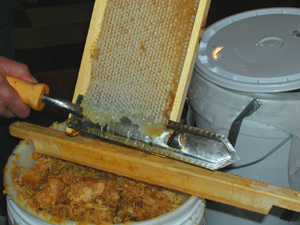
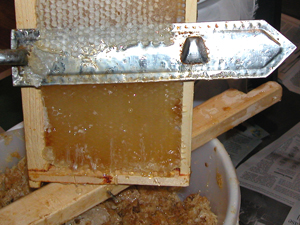
Well, then what? Depending on the size of the equipment you are using, you uncap either two or four or (if you have one of those really macho big electric extractors) dozens of frames, then you place them in a device that spins the honey out. This is a "honey extractor." The picture below comes from a catalogue, and it shows the business end of a 4-frame extractor like the one I borrowed from MaryEllen. You can see the opening at the top where the frames go in, and a crank for spinning them around. The white plastic thing at the bottom is the honey gate, where the extracted honey collects and can flow out.
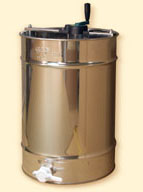
![]()
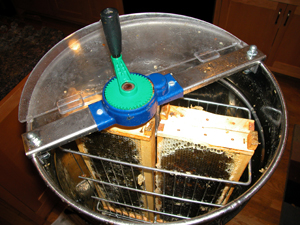
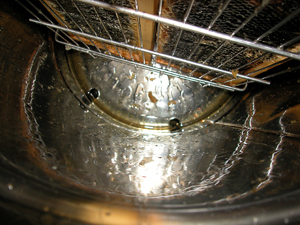
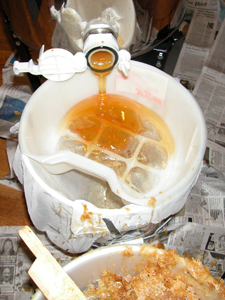
When the honey comes out of the extractor, it still contains bits of wax (that you can taste), chunks of pollen, and even random bee parts, so it needs to be filtered (or at least some of us think so). This honey went through 3 levels of filtration: a stainless steel screen about the gauge of a window screen, the ordinary paint filter you can see above (food safe HDPE plastic!), and a sheet of nylon curtain sheer material that you can see below it. None of these materials will deposit lint or other impurities in the honey, and they maintain a constant gauge in a way that nylon hosiery (used by many beekeepers) does not.
It takes a while for the honey, which is quite viscous, to flow through all those filters, so I balance a bucket lid over the top of all the stuff in that picture on the right, and get something to drink.
The newspapers you see in some photos are just to protect the floors. It's not hard to clean honey up, but hardwood can suck it up, and newspaper is just plain easy.
When the honey finally makes it through all the filters, I'll put them aside for washing, seal the bucket with a previously cleaned lid, go to bed, and dream of bottling on another day.
<< Home